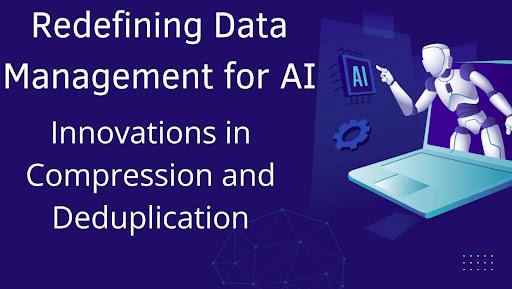The rise of artificial intelligence (AI) has led to massive data volumes, outpacing traditional storage solutions. In his latest work, Vamsi Krishna Rao examines cutting-edge data reduction techniques, including content-aware compression, semantic deduplication, and adaptive learning-based methods, offering innovative solutions for managing AI workloads without sacrificing data quality or performance.
Navigating the Complexity of AI Data
The rapid growth of AI and ML data introduces unique challenges. Unlike structured databases, AI data is unstructured, high-dimensional, and diverse, including images, audio, and text. Traditional compression and deduplication struggle with this complexity, requiring new methods that balance storage efficiency and computational demands.
The Limits of Conventional Techniques
Traditional compression methods like JPEG for images and ZIP for text provide moderate reduction but fall short for AI’s complex, high-dimensional data, risking loss of crucial features. Standard deduplication also struggles with diverse, redundant patterns in evolving AI datasets, necessitating adaptable techniques to preserve accuracy without excessive storage overhead.
Pioneering Data Reduction for AI: Content-Aware Compression
Content-aware compression tailors reduction to prioritize essential data features for AI tasks. For example, in image datasets, it preserves key details like edges crucial for vision models, while compressing less important areas, reducing storage needs and better maintaining model accuracy than generic methods.
Semantic Deduplication: Beyond Byte-Level Redundancy
Standard deduplication detects identical segments, whereas semantic deduplication identifies redundancies by interpreting data context. Especially useful in NLP, it merges text with similar meanings, reducing storage needs while maintaining linguistic diversity.
Adaptive Learning-Based Reduction: Real-Time Data Optimization
Adaptive reduction techniques offer dynamic compression by adjusting to data characteristics and AI task requirements. This ML-based approach optimizes parameters, fine-tuning reduction for specific tasks, like adjusting sampling rates in time-series data to reduce volume while maintaining predictive accuracy.
Distributed and Federated Approaches: Scaling with Privacy
As AI scales, data reduction extends to distributed systems, with distributed and federated methods enabling node-level compression, improving efficiency. Federated approaches enhance privacy by minimizing data transfers at the source, ideal for privacy-sensitive, compliance-focused applications.
Measuring Impact: Performance and Storage Efficiency
Assessing data reduction techniques for AI requires specific metrics, like compression-accuracy and compression-speed trade-offs, to measure effects on model accuracy and training speed. Content-aware and semantic deduplication outperform traditional methods, achieving better compression, preserving accuracy, improving storage efficiency, and shortening training times.
Designing AI-Optimized Storage and Workflow Integration
Integrating data reduction into AI workflows is key for seamless adoption, with advanced frameworks enabling compressed formats and on-the-fly decompression for training and inference. This enhances memory, storage, and access speed, while adaptable storage solutions meet AI’s changing data needs.
The Push Towards Energy Efficiency
Data reduction techniques can save significant energy by decreasing data transfer and storage needs, lowering AI’s energy footprint. Studies suggest that effective reduction methods can cut energy use by 15-25% in large-scale AI training, promoting greener, cost-effective AI operations.
Future Horizons: Quantum and Neuromorphic Innovations
With advancements in AI data management, innovations like quantum-inspired algorithms and neuromorphic compression hold promise. Quantum-inspired methods boost compression and processing speeds for complex data, while neuromorphic approaches, modeled after neural networks, provide energy-efficient, adaptive compression for real-time applications.
Privacy-Preserving Data Reduction for Sensitive AI Applications
As AI expands into sensitive data applications, privacy-preserving reduction techniques are increasingly essential. By leveraging methods like differential privacy and homomorphic encryption, these approaches achieve effective data compression while safeguarding privacy, making them well-suited for secure applications in finance, healthcare, and other sensitive fields.
In conclusion, Vamsi Krishna Rao underscores the transformative impact of advanced data reduction techniques in managing large-scale AI workloads. Approaches like content-aware compression and adaptive reduction provide efficient, scalable, and privacy-conscious solutions, setting the stage for more intelligent data management as AI technology advances.






